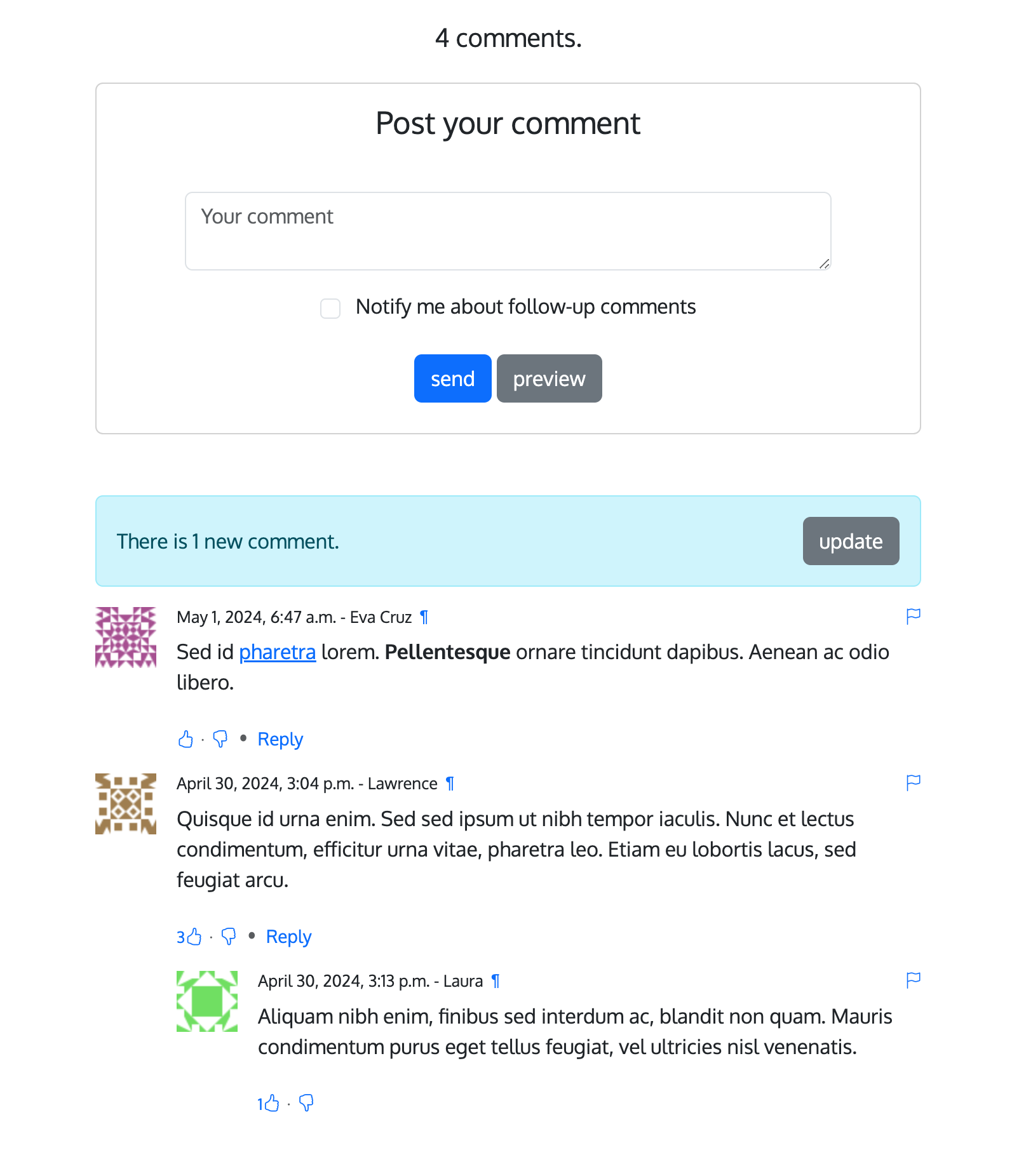JavaScript plugin¶
django-comments-xtd comes with a JavaScript plugin. When using the plugin comments are loaded and sent in the background, as well as like/dislike feedback. The plugin checks whether there are new incoming comments, and shows an update button that allows the user to refresh the comment tree. When the refresh takes place new comments are highlighted with a green label.

Frontend Stack¶
The JavaScript Plugin is based on:
Bootstrap
ReactJS
Remarkable (for Markdown markup support)
They are all external dependencies that have to be included as <script> elements in your templates (see demo sites’ base.html template).
The build process uses:
Build process¶
In order to further develop the current plugin, fix potential bugs or install the the plugin from the sources, you have to use NodeJS and NPM.
Set up the backend¶
Before installing the frontend dependencies we will prepare a Python virtualenv in which we will have all the backend dependencies installed. Let’s start by creating the virtualenv and fetching the sources:
virtualenv ~/venv/django-comments-xtd
source ~/venv/django-comments-xtd/bin/activate
cd ~/src/ # or cd into your sources dir of choice.
git clone https://github.com/danirus/django-comments-xtd.git
cd django-comments-xtd
pip install -e .
Check whether the app passes the battery of tests:
python -m pytest -x
As the sample Django project you can use the comp example site. Install first the django-markdown2 package (required by the comp example project) and setup the project:
cd example/comp
pip install django-markdown2
pip install django-rosetta
python manage.py migrate
python manage.py loaddata ../fixtures/auth.json
python manage.py loaddata ../fixtures/sites.json
python manage.py loaddata ../fixtures/articles.json
python manage.py loaddata ../fixtures/quotes.json
python manage.py runserver
Now the project is ready and the plugin will load from the existing bundle files. Check it out by visiting an article’s page and sending some comments. No frontend source package has been installed so far.
Install frontend packages¶
At this point open another terminal and cd into django-comments-xtd source directory again, then install all the frontend dependencies:
cd ~/src/django-comments-xtd
npm install
It will install all the dependencies listed in the package.json file in the local node_modules directory. Once it’s finished run webpack to build the bundles and watch for changes in the source tree:
npm run compile
Rollup puts the bundle in the static directory of django-comments-xtd and Django will fetch it from there when rendering the article’s detail page:
{% block extra-js %}
[...]
<script src="{% static 'django_comments_xtd/js/django-comments-xtd-2.9.13.js' %}"></script>
{% endblock extra-js %}
Code structure¶
Plugin sources live inside the static directory of django-comments-xtd:
cd ~/src/django-comments-xtd
tree django_comments_xtd/static/django_comments_xtd/js
Which results in:
django_comments_xtd/static/django_comments_xtd/js
├── src
│ ├── app.js
│ ├── comment.jsx
│ ├── commentbox.jsx
│ ├── commentform.jsx
│ ├── index.js
│ └── lib.js
├── tests
│ ├── comment.test.jsx
│ ├── commentform.test.jsx
│ ├── reducer.test.jsx
│ └── lib.test.js
├── django-comments-xtd-2.9.12.js
└── django-comments-xtd-2.9.12.min.js
The application entry point is located inside the index.js file. The
props passed to the CommentBox object are those declared in the
var window.comments_props defined in the django template:
<script>
window.comments_props = {% get_commentbox_props for object %};
window.comments_props_override = {
allow_comments: {%if object.allow_comments%}true{%else%}false{%endif%},
allow_feedback: true,
show_feedback: true,
allow_flagging: true,
polling_interval: 2000,
};
</script>
And are overriden by those declared in the
window.comments_props_override.
To use without the template, you can set up an endpoint to get the props by generating a view action within the Web API.
Improvements and contributions¶
The current ReactJS plugin could be ported to an Inferno plugin within a reasonable timeframe. Inferno offers a lighter footprint compared to ReactJS plus it is among the faster JavaScript frontend frameworks.
Another improvement pending for implementation would be a websocket based
update. At the moment comment updates are received by active polling. See
commentbox.jsx, method load_count of the CommentBox component.
Contributions are welcome, write me an email at mbox@danir.us or open an issue in the GitHub repository.
Comment design¶
photo | Header content | flags |------------------------------------------------- | Comment text that can take several lines all | together... blah blah blah... |------------------------------------------------- | Footer content |------------------------------------------------- | Nested comments...